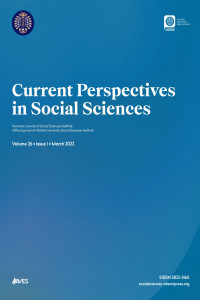The Effect of the Quantity of Writing Exams on De0veloping ESL/EL Writing Skills / İkinci Dilde Yazma Becerisinin Değerlendirilmesi Üzerine Nicel Bir Yaklaşım
Abstract: Feedback in ESL/EFL writing has been inconclusive. In literature, several studies
Anahtar Kelimeler:
Geribildirim, İkinci/yabancı dilde yazma, Hata düzeltme
-
Feedback in ESL/EFL writing has been inconclusive. In literature, several studies are available about the degree of the effect of the varying feedbacks (explicit vs. implicit; coded vs. uncoded, etc.) on the learners’ motivation and success. The effect of optimum number of writing exams on the success of L2 learners may be important as much as the effectiveness of feedback types on learners’ errors in their compositions. The aim of this study is to investigate the impact of number of writing exams on the linguistic errors in EFL/ESL student compositions. In this study there are two groups (e.g. experimental and control groups) consisting of 20 intermediate level students, each studying in the Department of Tourism Guidance at a state university in Turkey. Control group participants took three administrative examinations, which are two midterm exams and one final exam and experimental group participants took three more exams. No feedback was provided for students compositions. The results showed that group students who took more three exams (e.g. experimental group) slightly outperformed those of control group.
Keywords:
Feedback; EFL/ESL Writing, Error Treatment.,
___
- Ashwell, T. (2000). “Patterns of teacher response to student writing in a multiple-draft composition classroom: Is content feedback followed by form feedback the best method?”. Journal of Second Language Writing, 9(3), 227-258.
- Chandler, J. (2003). “The efficacy of various kinds of error feedback for improvement in the accuracy and fluency of L2student writing”. Journal of Second Language Writing, 12(3), 267-296.
- Delgado, R. (2007). Effects of Different Error Feedback: Approaches in Students’ Ability to Self-edit Their Writing. Divergencias. Revista de Estudios Lingüisticos y Literarios, 5 (2), 7.
- Efe, H. (2008). “Punctuation Mistakes Committed by Lycée Graduate Turkish Students”. Atatürk Üniversitesi Edebiyat Fakültesi Sosyal Bilimler Dergisi, Cilt : 8, Sayı: 41, Erzurum
- Ellis, R. (2001). “Investigation form-focused instruction”. In E.Rod (Ed.), FormaFocused Instruction in Second Language Learning, (pp. 1-46). Malden, MA: Blackwell Publishers.
- Ferris, D. R. (1997). The influence of commentary on student revision. TESOL Quarterly, 31(2), 315-339.
- Ferris D. R. (1999). “The case for grammar correction in L2 writing classes: A response to Truscott (1996)”. Journal of Second Language Writing, 8 (1), 1-11.
- Ferris, D.R, Chaney, S.J., Komura, K., Roberst, B.J., & McKee, S. (2000). Perspectives, Problems, and Practices in Treating Written Error. Colloquium Presented at Intenational TESOL Convention, March 14-18, Vancouver, B.C.
- Ferris, D. & Hedgcock, J.S. (1998). Teaching ESL Composition: Purpose, Process, and Practice. Mahwah, NJ: Lawrence Erlbaum Associates.
- Ferris, D. R. & Roberts, B. (2001). Error feedback in L2 writing classes: Howexplicit does it need to be? Journal of Second Language Writing, 10(3),161-184 Ferris, D. R. (2002). Treatment of Error in Second Language Student Writing, USA: University of Michigan Press.
- Ferris, D. R. (2003). Response to Student Writing: Implications for Second Language Students. Mahwah, NJ: Lawrence Erlbaum.
- Fratzen, D. (1995). “The effect of grammar supplementation on written accuracy in an intermediate Spanish content course”. Modern Language Journal, 79(3), 329-3
- Hedgcock, J. & Lefkowitz, N. (1994). “Feedback on feedback: Assessing learner receptivity to teacher response in L2 composing”. Journal of second language writing, 3, 141-163.
- Kepner, C. G. (1991). “An Experiment in the relationship of types of written feedback to the development of second-language writing skills”. The Modern Language Journal,75(3), 305-313.
- James, C. (1980). Contrastive Analysis. London: Longman.
- Lado, R. (1957). Linguistics across cultures: Applied linguistics for language teachers. University of Michigan Press: Ann Arbor.
- Lane, J., & Lange, E. (1999). Writing Clearly: An Editing Guide, 2 nd Edition. Boston: Heinle and Heinle.
- Liu, Y. (2008). The effects of error feedback in second language writing. Arizona Working Papers in SLA & Teaching, 15, 65-79.
- Madsen, H. S. (1983). Techniques in Testing. New York: Oxford University Press.
- Raimes, A. (1992). Grammar Troublespots. New York: St. Martin’s Press
- Truscott, J. (1996). “The case against grammar correction in L2 writing classes”. Language Learning, 46(2), 327-369.
- Truscott, J. (1999). “The Case for the case against grammar correction in L2 writing Classes”. A Response to Ferris. Journal of Second Language Writing, 8 (2), 111-122.
- Truscott, J. (2004) Evidence and conjecture on the effects of correction: A response to Chandler. Journal of Second Language Writing, 13, 337 – 343.
- Truscott, J. (2007). “The effect of error correction on learners’ ability to write accurately”. Journal of Second Language Writing 16(4), 255-272.
- Truscott, J. (2009). “Arguments and appearances: A response to Chandler”. Journal of Second Language Writing 19(1), 59-60.
- Van Beuningen, C.G., De Jong, N.H., & Kuiken, F. (2008a). “The effect of direct and indirect corrective feedback on L2 learners’ written accuracy”. ITL International Journal of Applied Linguistics 156 , 279-296
- White, E. M. (1985). Teaching and assessing writing: Recent advances in understanding, evaluating, and improving student performance. San Francisco: JoseyBass.
- Başlangıç: 2003
- Yayıncı: Atatürk Üniversitesi
